Leonardo's Bicycle
← Back to main index
Leonardo's Bicycle
Unlike other possible unrecognized transmissions from classical times this one got a lot of public debate. Some saw it as unbelievable and called it a modern fraud. The public dispute went beyond academic custom and created some bitterness. A careful new look at the subject seems overdue.
The Find
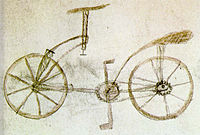
The famous bicycle sketch in Leonardo's Codex Atlanticus.
Since 1636 the codex stayed with the Bibliotheca Ambrosiana of Milan. From 1966 to 1969 the Ambrosiana gave the codex for restoration to the "Laboratorio di Restauro" of Grottaferrata. Because the Ambrosian Library belongs to the Vatican, the archbishop of Milan requested the work be done by the monks of cloister Grottaferrata near Rome.[3]
.jpg)
A modern box replica of the pre-restauration Codex Atlanticus.
Based on the restoration in 1974, a facsimile edition of the codex[5] and a book "The Unknown Leonardo" were published.[6] The latter covered the Codex Madrid found in 1967, too. Both publications had facsimiles of the bicycle. The bicycle sketch was first presented to the public in a lecture by Augusto Marinoni in spring 1974. Marinoni actually found it on the photography and no report by the monks of Grottaferrata is published yet.[7]
The Pedretti Prior Find
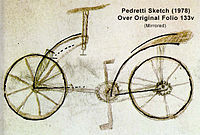
The line sketch published 1978 by Carlo Pedretti about his prior find in 1961. It is here mirrored and overlaid on folio 133v. The good fit suggest it was redrawn from over 10 year old memories after he lost his notes in 1965.
- "When I examined the original sheets in 1961, holding them against a strong light so as to detect elements of their (at the time) hidden versos, I noticed the presence of scribbles in black chalk as well as light traces of circles in pen and ink, which appeared to be the beginning of some geometrical diagrams. These have turned out to be part of a rough sketch of a vehicle that resembles a bicycle. Similar rough sketches, not by Leonardo, are found on other sheets of Leonardo’s manuscripts and drawings."
He included a sketch from memory of what he saw in 1961. His original notes were stolen with his car in 1965.[9] Pedretti claims he saw two circles with curved lines bisecting them but not a whole bicycle sketch. He thinks the sketch and the graffiti were probably not from Leonardo’s time. After the news in 1974 he stated "Folios 132 and 133 hardly deserve the attention they have received".[10] But given the importance of the subject and the forgery accusations, it is unfortunate they did not get the attention they deserved.
The sketch Pedretti presented 1978 as drawn from memory fit perfectly on the original bicycle sketch. So it was only a redrawing of parts of it. He did not address the problem that in translucent light the central parts of the bicycle were covered by the fortification drawing from the other side, and that he had to look through three sheets (F133, the carrier, F132) of which four pages had drawings. To identify something totally unexpected in such a chaos was hardly possible. The lines he noted were already good recognition work. Pedretti gave no explanation how the "scribbles" could be from later time when the original sheet they covered was cut in two certainly before 1608.
The Pedal Drive
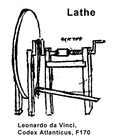
First lathe with treadle power by Leonardo da Vinci. Codex Atlanticus, Folio 170, c. 1490.
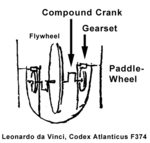
Paddle-Wheel Boat. First feet driven vehicle by crankset, c. 1490. Two compound cranks, gears and a flywheel. Codex Atlanticus Folio 374.
According to that view the crankshaft came up around 1420[12] in the north and was still little known in Italy around 1450.[13]
The first multiple hand powered crankshafts were depicted by Robertus Valturius in 1463 and later by Leonardo da Vinci.[14] But the first feet powered vehicle using cranks was a French coach c. 1750.[15]
Given this seemingly long way to a bicycle crankset it was unbelievable that Leonardo had invented it already in the 1490s. The crankset was such a simple human power source, why were the large treadmills then still used for centuries?[16]
The crank theory of White Jr. collapsed in the 1980s after the find of a Roman metal crankset became public. His theory had not accounted for the transmission statistics.[17] Further, the first mention or depiction of a technical invention does not indicate it was invented then. Rather simple things could be much older.
A feet powered treadle machine was depicted by Leonardo as a lathe around the same time[18] and by a German engraver as a grindstone.[19]
The first feet powered crankset vehicle, a paddle-wheel boat c. 1490, was depicted by Leonardo around the same time too.[20] So the pedal drive is no longer an argument for a fake.[21] But it should be known why it was one in the 1970s.
The Salai Link
.jpg)
Portrait of Gian Giacomo Caprotti, known as "Portrait of Salai" by Leonardo da Vinci, 1495 oil on panel. From the collection of the Alos Foundation.
At the suggested time of the drawing, 1493, Salai was about 13 years old. The other pupils were teens too and not much older. Salai worked as an assistant and model for Leonardo and became a painter. Some 16th century writers suggested their relationship went far beyond teacher and pupil.[22] If true it may be a hint how Salai got his information.[23]
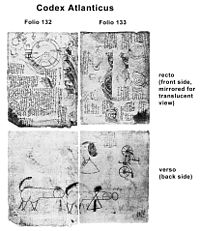
Both sides of folio 132 and 133. The graffiti proves that both were originally one sheet. The fortress sketch on the front side of folio 133 just blocks the center of the bicycle in translucent view. Exactly there Pedretti's line sketch has the missing gap. It suggests he really saw some of the bike but a part was blocked.
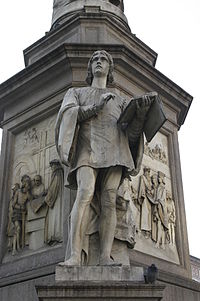
Statue of Gian Giacomo Caprotti ("Salai") at the Piazza della Scala in Mailand.
Details of the bicycle sketch suggest the kid only saw some drawing but did not fully understand the mechanism. Some errors suggest what he saw was in perspective view he was unable to copy from memory.[27]
The Codex Madrid Link
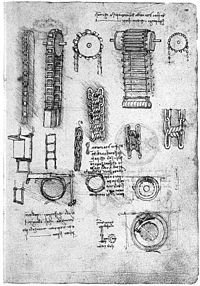
The famous chain page of Codex Madrid I, folio 10r. The find was in the news in 1967 as bicycle chains. In 1983, Foley, Blessman and Bryant noted the band brake sketches in the lower half.
The Codices Madrid I and II are bound in red Moroccan leather and contain together 349 folio sheets with drawing and text by Leonardo. Madrid I is Leonardo's masterpiece collection of mechanical "gadgets, gears, and inventions".[30]
It was bound into a codex by Leonardo himself. It has survived almost intact, except for 16 pages, which have been torn out and seem to have been lost.
The find of these two codices in 1965 was "the most important 20th century find in a library and the most important Renaissance find ever."
It was found by chance when the Bostonian Romanist Jules Piccus searched for poetry manuscripts. He went systematically through the catalog but continued the orders to the next signatures in the hope to get more poetry writings. Instead he found in the reading room the lost codices of Leonardo. He immediately recognized the unique script and ordered to microfilm the codices. He presented his discovery with Ladislao Reti to the international press on 7th Feb. 1967 in Boston.[31]
There was a search for the codices in the National Library of Madrid in 1898 and it is hard to understand why it was not found among only 30,000 manuscripts.[32] Two other but less credible stories circulate about the 1965 find.[33]

The chains of Codex Atlanticus and Madrid I in context. Left a heavy chain with rounded elements to fit around a toothed wheel. The wheel would have fewer teeth than usual today. Below (Folio 56v-b) a chain type Marinoni found close to modern ones. Center the 5th folio of Codex Madrid I where Leonardo suggested toothed wheels with round heads. But later on folio10v he drew cubic heads that would not work.
In 1997 Lessing suggested that this news was the motivation to create the bicycle fake. But the drawings of these chains in Madrid I were around the same time Leonardo made the fortification sketches on the bicycle folio too.[36] So Salai and his other pupils at this time had access to the chain drawings too.
The cogs of one chain in Madrid I had a cubic shape that won't work. Some of the cogs at the bicycle had that error too. But others at the rear wheel seemed to be of a more pointed shape. The cubic shape error suggests that the kid did a redrawing from memory and was fooled by a sketch today in Madrid I.
The Marinoni Reconstruction
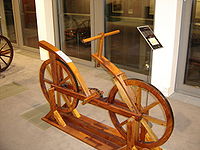
An interpretation of Folio 133v by Antonio Calegari. It is not steerable and was the only reconstruction until 1983. It therefore was suggested by Leonardo scholar Augusto Marinoni since 1974 and better known by his name.
- "...the vehicle could never function like a real bicycle...In fact, these were not actual machines, but simply ideas: this sketch represents the first conception of a bicycle that ever took root in a man's imagination. And that man could only have been Leonardo."
But from a technical point of view Marinoni created an impossibility. An unstable two wheeler is no inventive idea but makes no sense at all. It would be laughably crazy around 1500. Why not to use a tricycle instead? Additionally, any technician would as his first idea have placed the pedals on the front wheel hub to avoid the costly chain drive. But even with a steerable bicycle that would not work either. The pedal forces would interfere with the forces of the gyro or trail stabilization. So a chain drive makes only sense if the inventor already tried the front wheel pedals and failed there. But a fixed front wheel is nowhere in such a possible line of development. It is really unbelievable for a person with technical background.
The Hub-Center Steering
In 1983, a paper by Foley, Blessman and Bryant changed the whole problem of Leonardo's bicycle.[39] It suggested that it was steerable but in a way never ever built in modern times. The front wheel was in a wide fork and could maybe turn up to 15° to each side. That was sufficient for any normal operation. Such a design allowed the wheel the small gyro stabilization movements needed to be a stable bicycle. It is today known as "hub-center steering" (HCS) because it got some use again for motorbike racing since the mid 1980s.
During their work they had support by the cycle specialist Derek Roberts.
He found that in 1885 the British Quadrant Bicycle Company built bikes with hub-center steering but only for a few years.[40] Therefore after this 1983 paper the term "Quadrant steering" came up too.[41]
The paper somewhat focused on a Quadrant like design but suggested different ways to realize it. They thought the inverted "T" below the handlebars was directly involved in the steering. After prior work of Foley and Bryant a full scale proof of concept model (0.5 m wheels) was built by Edward R. Blessman in 1980. The front wheel was suspended by chains. It was the simplest way to realize a hub-center steering but difficult to predict analytically.
It was possible to ride the bike. Blessman: "Riding was odd. It always wanders a bit, won't track real straight. But on a rough surface that might be helpful." It was unstable at higher speed. Probably the chains interfered with the gyro forces. A chainless more complicated version with levers was drawn in the paper of 1983 and later built.[42] It had some distant link to the racing HCS of the later 1980s.[43]
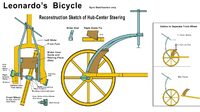
A recent interpretation of folio 133v. It uses hub center steering as first suggested in 1983. But it is realized in a different way and looks closer to the original sketch of 1493. This design was never built in modern times.
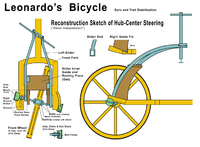
Another recent interpretation of folio 133v with hub center steering. But here the gyro stabilization was supplemented by a trail stabilization for low speed. It looked even closer to the sketch of 1493. The validity of this design concept could only be proven by building a vehicle.
Comparing this new interpretation with folio 133v suggests the visible axle is in the most forward position. That is to be expected from a maximum right turn of the wheel. The sliders of 133v are sketched in shifted position which agrees with that situation too. So the original drawing Salai saw was probably intended to explain the function of the hub-center steering. It seems unclear whether the kid really understood the principle of what he drew but he did a good job from memory. The sketch of folio 133v shows now some unique indications for hub-center steering:
- The axle is below the girder
- No visible axle fixture to keep it in place
- The steering rods (sliders) end near the hub
- The steering rods are able to shift (but not to turn) by the turn of the handlebars
- The steering rods and axle are depicted in corresponding extreme position
- The clamp at the axle end is inclined like for trail
The Forgery Accusations
The 1983 paper should have stopped any forgery accusations because the sketched design suggested now a plausible way of development.[45] Unfortunately it was written in German and due to the technicalities not easy to understand. It did not become widely known. In 1987 even Marinoni kept to his fixed front wheel and did not mention this paper.
The most vocal fraud accusations came in August 1997 by Hans-Erhard Lessing. Lessing was retired curator of the Museum of Technology and Labour
in Mannheim - the German city where Karl von Drais built the first bicycle in 1817. It seems Lessing saw it as his duty to defend the priority of Drais. In 1997 he presented the Lenardo sketch together with a French and a British priority claim that were both already dismissed by historians.[46]
Lessing cited the 1983 paper but did not mention the hub-center steering. He maintained that the sketch showed a non-steerable two-wheeler. He pointed out that this was similar to a myth created in France in the 1890s about a French priority by de Sivrac of 1791. That myth lasted until 1976. Therefore Lessing argued that any forgery before 1976 must have held the idea that the first bicycle must be non-steerable.
Lessing suggested that on the back of folio 133 only those lines reported by Carlo Pedretti in his "drawing from memory" existed. After the Madrid news in 1967 someone in the lab at Grottaferrata drew in the remaining lines. "It's the sort of thing a bored monk might do," one bicycle expert told New Scientist.[47] According to Lessing all happened with the intention to get the priority for the bicycle invention for Italy.
Unfortunately in his paper Lessing called Marinoni a liar.[48] The whole discussion further derailed after journalists - inspired by Lessing's paper - suggested the monks and Marinoni were directly involved in the forgery. Lessing never claimed that but it is the impression some readers may have gotten. Marinoni, "one of the great Leonardo da Vinci scholars of his generation",[49] died 4 months later aged 86.
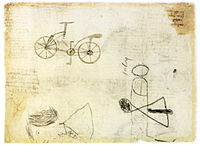
A color photo of folio 133v shows the bike fainter than the graffiti. Therefore no visible stamp traces are to be expected.
Who designed it?
The hub-center steering allows a plausible line of development but one that has to be done on full scale vehicles. No traces of it are found in the records of Leonardo. It could belong to the lost 75 % pages of his work. But we can be sure that Leonardo never built the bike in the sketch. Had he built it (or the necessary precursors during development) the news would have spread rapidly over Europe. A person running on a two-wheeler in 1493 was such an unbelievable sight that it was big news. And Leonardo had to make a living from the news of his achievements.
The designer of the depicted bicycle did know that it worked. He had solved the stability and steering problem with built precursors.[51] For a first proof of concept he would not have needed the chain drive, neither had Drais. Therefore it was rather simple and the designer would have built it. That Leonardo did not build it indicates he was not the designer.
Who was it? Leonardo lived in the Renaissance. A time when after 1000 years classical texts were collected and read to improve science and living. Leonardo often refers to classical sources in his notebooks.[52]
A straight and simple explanation for the sketch is an origin in a transmitted book from classical times. The kid who did it may actually have seen a drawing in such a source. No such book is known today. But Roger Bacon in the 13th century mentioned a book that presented mechanical and other wonders of the ancients. One was a vehicle that moved itself without horses, like the spring driven gadget Leonardo had in one of his notebooks. A stable two-wheeler in such a book may have been seen by some as a piece of magic and a case for the deadly Secret Courts. The explanation for the stable bicycle needed the gyro theory of the later 19th century.
A Roman origin
There are further issues that may point to a late[53] Roman time origin. Foley et al in their 1983 paper suggested the poor roads around 1500 may be a contributing factor to the non-adoption of the bicycle then. This bike with the size of a modern "safety" was more affected by poor roads than modern ones with tires. Depending on the road condition walking in 1500 could be more energy effective than a bike.
The Romans had the best roads and the most energy effective land transport before the 19th century railways. Their roads were not just hard but a lot had two carved rail ruts, grooves for wagon wheels. These ruts were especially smooth to further enhance the efficiency. The depicted bicycle would have been a perfect vehicle then. It was suggested some Roman roads in Britain with only a single rut were related to the bicycle.[54]
This bicycle on a Roman road would be in speed and range similar or superior to horses but much cheaper in daily costs. It had the advantage that its approach would be more silent. A military patrol had a better chance to surprise barbarian intruders. Some other economic advantage may be in mail and individual transport. But the design was neither simple nor cheap and had to rely at least on some small industrial base.
The skills of the best 1400 European metal and wood work may be sufficient. But the individual costs for single bikes of that type (because of the metal parts) were so high pre-1800 that a horse would be cheaper. The suggested bike only had an economic chance in serial production. In contrast the Drais design with no gyro but only simple trail stabilization could well be built in single units. It was a better suited modern beginning.
Notes
- Jump up ↑ There is some controversy whether ink was used.
- Jump up ↑ See "The Salai Link" below
- Jump up ↑ The Leonardo da Vinci Bicycle Hoax. Lessing, Hans-Erhard: The Evidence against "Leonardo’s Bicycle" Text of a paper presented at the 8th International Conference on Cycling History, Glasgow School of Art, August 1997.
- Jump up ↑ On the Question of Leonardo's "Bicycle"
- Jump up ↑ Il Codice Atlantico di Leonardo da Vinci. Transcribed by Augusto Marinoni, Giunti edition. Florence 1973-1975. 25" high, 998 copies printed.
- Jump up ↑ Ladislao Reti (ed.): The Unknown Leonardo, 3 volumes. McGraw-Hill, New York, 1974. In Vol. 2, Appendix: "The Bicycle" by Augusto Marinoni.
- Jump up ↑ It is hard to believe there was no news interview published after the forgery accusations. But it is not in cited references of the works used here.
- Jump up ↑ Pedretti. Carlo: The Codex Atlanticus of Leonardo da Vinci: A Catalogue of its newly restored Sheets. 2 Vols., New York, 1978
- Jump up ↑ Lessing (1997), note 22. Based on a personal communication with Pedretti in 1997 and "Carlo Pedretti. Leonardo da Vinci - The Royal Palace at Romorantin. Harvard University Press, Cambridge, 1972, p. 142."
- Jump up ↑ In his book he was even more dismissive: "The scurrilous scribble of a pupil on the verso of a two-part sheet of fortification studies, ff. 132 and 133, hardly deserve the attention they have received in recent publications, and even less so does the sketch of a bicycle."
- Jump up ↑ Lynn White Jr.: Medieval Technology and Social Change (1962)
- Jump up ↑ White (1962), p. 112f
- Jump up ↑ Giovanni da Fonatana made a mechanically misunderstood sketch of a cranked auger c. 1420-29. An early crankshaft there was still wrongly depicted by Mariano di Jacopo Taccola, c. 1441-1458. White (1962), p. 112f
- Jump up ↑ His famous "tank" sketch showed it, but it was probably never built. Note the Architronito connection between Leonardo and Valturius.
- Jump up ↑ Wilson, David Gordon: Bicycle Science, (2004), p. 312
- Jump up ↑ The answer is more complicated. An engineer suggested it was momentum related. A treadmill gives over 10 times the momentum of a crankset. Both have similar power but most applications needed a high momentum. A high momentum means a high force, not a high speed. To gear the crankset in a high momentum was a costly and inefficient way before the mass production of metal gears and metal bearings.
- Jump up ↑ He failed to consider that we have a much larger number of texts and pictures from medieval and Renaissance times than from classical times. Instead by weighing the limited classical evidence heavily, he eliminated them in his book.
- Jump up ↑ Codex Atlanticus, folio 170. Presented by Feldhaus, Franz Maria: Leonardo, der Techniker und Erfinder. (1922), p. 54.
- Jump up ↑ The German was Israhel van Meckenem. He was active from 1465 until his death in 1503. So the time is estimated to c. 1480. His engraving is shown in A. Schroeder: "Die Entwicklung der Schleiftechnik" (1931), p. 60, fig. 58. According to White (1962), p. 167.
- Jump up ↑ It had two compound cranks, gears and a flywheel. Codex Atlanticus Folio 374. In contrast with the other paddle boats it is intended to be powered by only one man. Presented in: Feldhaus (1922), p. 124. The exact year of this drawing is not known but it was likely before the bicycle sketch whose folio is dated well by Leonardo's drawings to 1493.
- Jump up ↑ It was not mentioned by Lessing (1997).
- Jump up ↑ So Giorgio Vasari (1550). He reported that "Mona Lisa" may be an anagram for "Mon Salai" (My Salai). Giovanni Paolo Lomazzo (c. 1563) directly suggested a sexual relationship and even defended it. See the German Wikipedia for details.
- Jump up ↑ Salai may have had a similar most secret relationship with some other person. As gratification this person may have granted him access to a most secret book. His good memory work at 133v proved that Salai was very fascinated by this material. Salai then gave his information to Leonardo. So he could be his spy kid.
- Jump up ↑ Leonardo recorded him as liar and he stole silver pencils and money from other pupils
- Jump up ↑ The bleeding through of his ink was minimal and would have allowed the use of both sides like he did elsewhere, Marinoni noted.
- Jump up ↑ Marinoni presented evidence based on Leonardo's writing that the sheet was already parted in 132 and 133 as Leonardo began to use it.
- Jump up ↑ The bowed mounting of the handlebars is drawn like from a perspective view. The front fork is drawn like from a perspective view but crossed by a side view.
- Jump up ↑ Brake, cylinder- and ball-bearings, chain drive
- Jump up ↑ Vernard Foley, Edward R. Blessman, James D. Bryant: "Leonardo da Vinci und das Fahrrad", Technikgeschichte, 50 (1983), Nr. 2, pp. 100-128
- Jump up ↑ Other subjects were architecture, geometry, music, navigation and maps.
- Jump up ↑ Der Spiegel (Hamburg), 06.03.1967, No. 11/1967, p. 137. Newsweek (New York), 27.2.1967, p. 43
- Jump up ↑ According to Der Spiegel 11/1967. The script was very easy to recognize and one person could well check 30,000 codices in only two months. It had its original signature and was in the location for this signature, too. The catalog card mentioned mechanical drawings too.
- Jump up ↑ (1) According to "Der Spiegel" (1967) the director of the Madrid library, Miguel Bordonau Más, explained to the "New York Times": The books were never lost but wrongly cataloged. Both were found in the late 1950s and in 1965 presented in an exhibition. But the catalog of that exhibition is not available in the library. Since then the two codices were available in the library but nobody asked about them, so Bordonau Más claimed. "Der Spiegel" doubted his story.
- (2) According to the introduction in Reti (1974) - not written by Reti but anonymous - the two volumes were found 1965 in the National Library of Madrid after some historians requested a search. The codices were then found at the place of their original signature. So why was it lost for over 100 years if it stood in the original place? Why were these very visible volumes not found by an earlier stocktaking or search? The signature was in place and the handwriting of Leonardo was very unique and well known. Why was there no news about this sensation in 1965?
- Jump up ↑ According to the note by Leonardo it was for lifting purposes. But it doesn't take a genius to use it for power transmission.
- Jump up ↑ Newsweek (New York), 27.2.1967, p. 43, sporting the caption "Leonardo’s bicycle-like drives,". Lessing (1997) found some other very similar news.
- Jump up ↑ The codex Atlanticus with the bicycle sketch has a page with chains usable for a drive too. Reproduced in: Grothe, Hermann: Leonardo da Vinci, Berlin 1874, pp. 86f. That further suggested both were from the same time.
- Jump up ↑ Ladislao Reti (ed.): The Unknown Leonardo, 3 volumes. McGraw-Hill, New York, 1974. In Vol. 2, Appendix "The Bicycle" by Augusto Marinoni.
- Jump up ↑ Galluzzi, Paolo (Ed.): Leonardo da Vinci, engineer and architect, Montreal, 1987, Chapter "Leonardo's Impossible Machines" by Augusto Marinoni, pp. 111-130
- Jump up ↑ Vernard Foley, Edward R. Blessman, James D. Bryant: Leonardo da Vinci und das Fahrrad, in: Technikgeschichte, 50, no. 2 (1983), pp. 100-128.
- Jump up ↑ Two are seen here at the right (1st and 3rd).
- Jump up ↑ Neither "hub-center steering" nor "Quadrant steering" or similar German terms are used in the 1983 paper. Both came up later.
- Jump up ↑ A photography is on page 101 in: Foley, Vernard: "Leonardo and the Invention of the Wheellock", Scientific American, January 1998, pp. 96-101
- Jump up ↑ The inverted "T" moved two horizontal rods above the wheel. They were clutched to two rods vertically coming from near the hub. Near the hub was a small lever that could press the wheel right or left like in a modern HCS. Not all details were visible on the small sketch in the 1983 paper.
- Jump up ↑ This design came step by step. First were the sliders and the rollers. Then came a critique that the lateral forces are underestimated. So the end blocks were added. Then a suggestion to give it a trail stabilization and to consider the ancient spring steel of less quality. So the grooves were inclined by 15° and the clamp enlarged. With each step the result looked more similar to the Codex Atlanticus sketch.
- The Wikipedia graphic is a sketch too and no blueprint to take measurements from. Some parts and gaps are oversized to better explain the design. A fit to the materials of choice and to the human proportions is mandatory. The bicycle is in size like our modern ones. Only the steering is different so only this part is depicted.
- Sliders: Suggested by steel but stiff plywood like a Roman shield may work better
- Axle End Block: To keep the lateral forces
- Fork stop bolt: to counter a vertical push on the fork that it stays with the roller or end block. The sliders may be able to rotate forward. The high of the bolt position and a not sketched groove in the fork front could provide this bolt rotation. Then the wheel, axle and sliders could be parted from the fork.
- The inverted T below the handlebars: To reassemble a parted bike this T would be a convenient grip to rotate the sliders back and forth.
- To work in gyro stabilization the mass distribution and low friction could be crucial. The HCS and the wheel hub should be of low mass and the iron wheel rim heavy. So the front wheel could be more heavy than the rear one.
- Jump up ↑ The hub-center steering was a way to allow partial gyro stabilization like a free wheel would have. A probable first try of pedals on the front wheel led to poor results due to gyro interference which next led to the chain drive and the design we see at 133v.
- Jump up ↑ So Lessing (1997)
- Jump up ↑ According
to The Newsreel, by Jay Maeder, October 17, 1997
- Jump up ↑ Lessing (1997) about Marinoni: "but having lied once, he will no longer be believed by academia." The "lied once" refers to Marinoni's claim that the drawing from Codex Madrid I could not be known to a forger before the publication in 1974. Marioni forgot that the crucial drawing was already published by the press in 1967. So Marinoni made a mistake. But that he deliberately deceived the reader, that he lied, was not proven by Lessing.
- Jump up ↑ Academic obituary Professore Augusto Marinoni
- Jump up ↑ Lessing (1997): "However, an important piece of evidence in dating the bicycle sketch is that it is not from Leonardo's hand and produced no visible set-off overleaf in contrast to the obscene scribbles surrounding it - an indication that it has been put in after the unfolding of the sheet." All back side drawings were by some type of (oil- ?) crayon. The thickest parts of the graffiti left a visible trace at the other folio sheet it was folded with. But not all lines of the graffiti did. If one examines a color photo, the bicycle looks fainter than the graffiti. It is therefore not to be expected to create visible traces on the other sheet. But a detail investigation by microscope or special light may reveal some. Lessing may be confused by the black and white images where the bike has similar contrast like the graffiti. But in reality it does not.
- Jump up ↑ There was no way to solve those problems by theory alone. Each step had to be built at full scale and tried.
- Jump up ↑ Although those references were often omitted by Leonardo scholars who instead suggested he built the machines on his own. See the Architronito case.
- Jump up ↑ It must be late (4th century) because otherwise it would be mentioned in our transmitted texts. It lacked further stages of development like our modern simple way of gyro stabilization. Its further development must have stopped due to the collapse of the classical civilization in the late 4th century.
- Jump up ↑ Like this in Blackstone Edge, Rishworth Moor, Greater Manchester or this. The present interpretation is a drainage function. How that could usefully support the drainage channels at the sides of the convex road body is not easy to understand.

